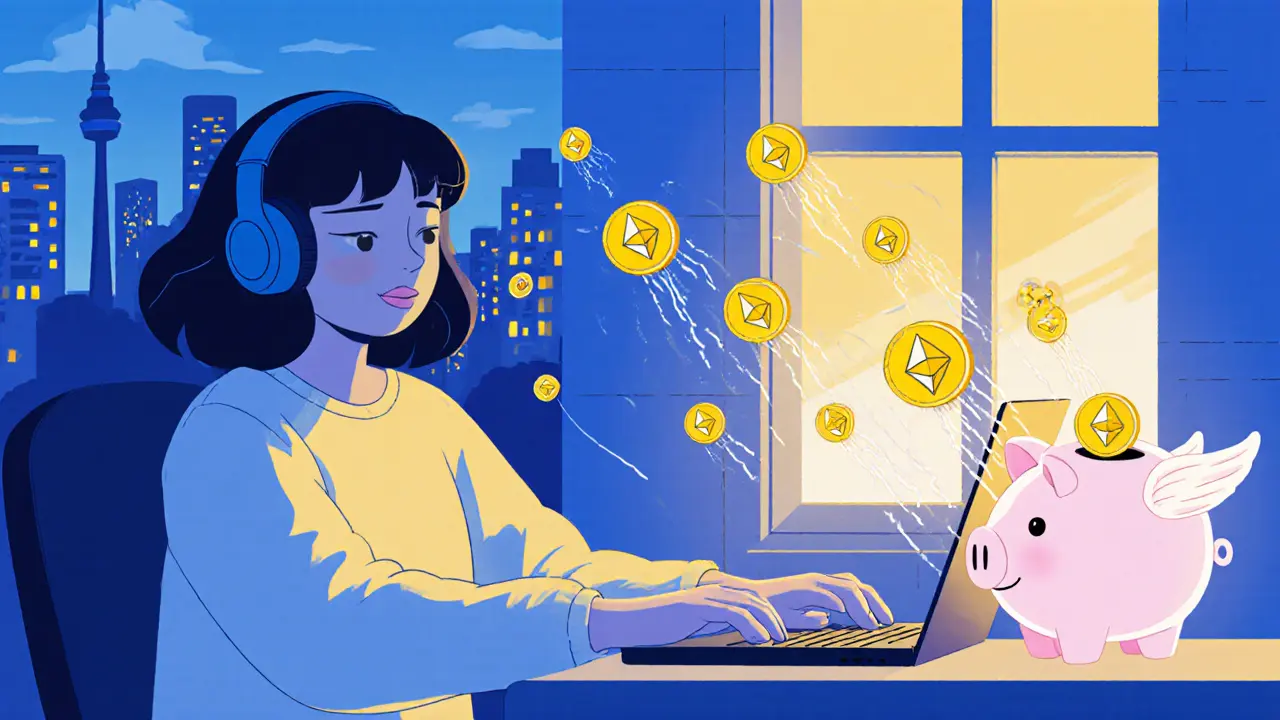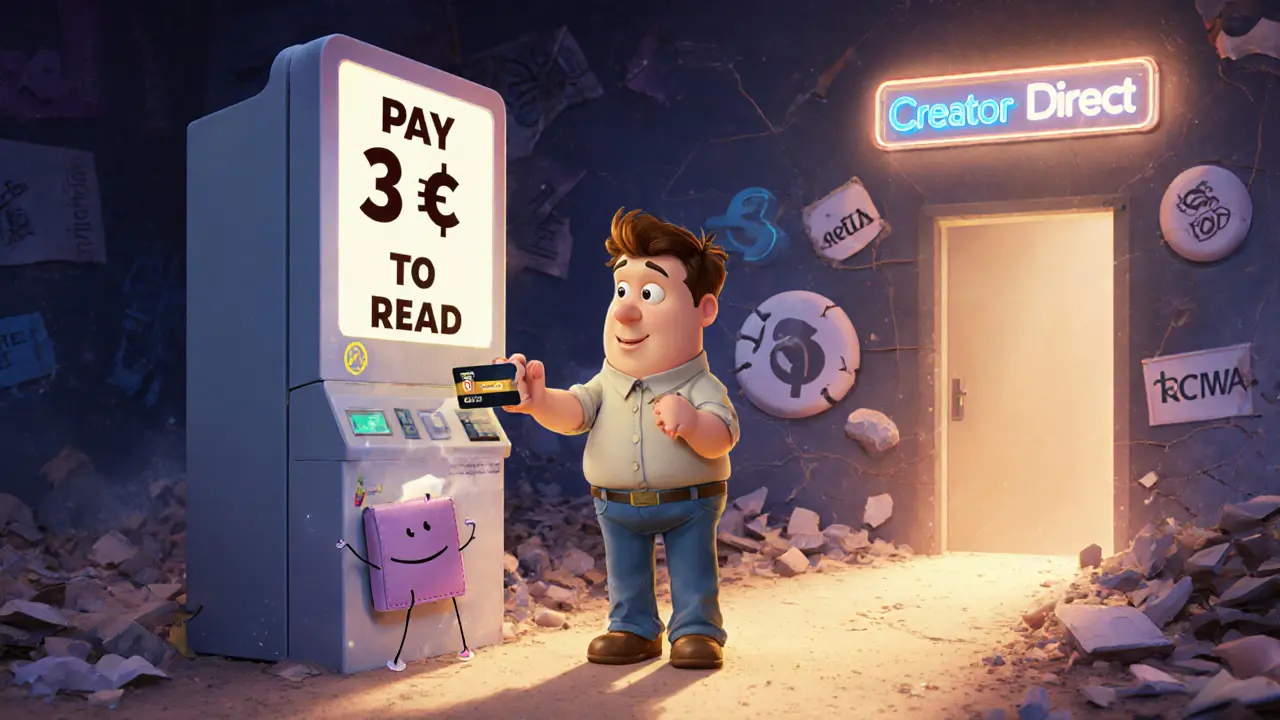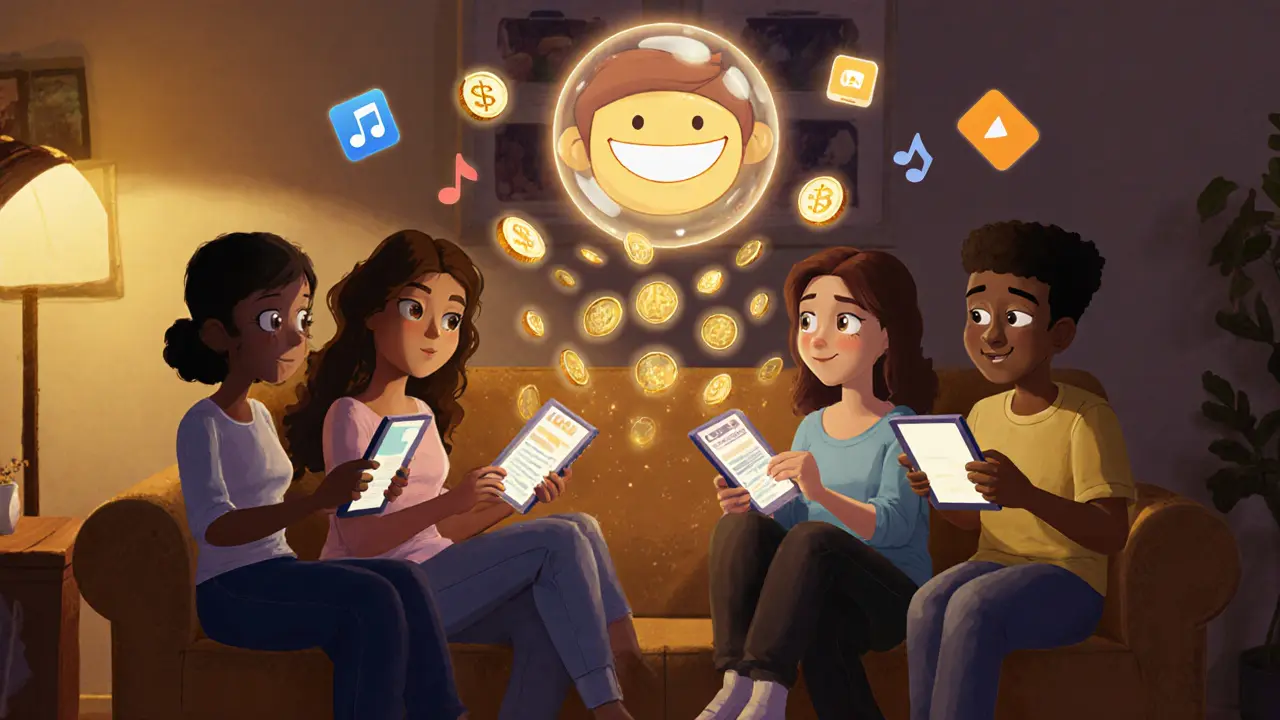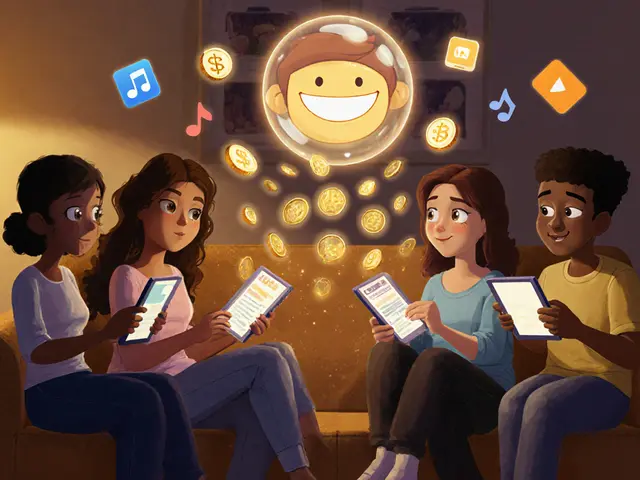Creator Earnings Calculator
How Blockchain Changes Your Earnings
Traditional payment systems take 10-30% fees on small transactions. Blockchain micropayments typically take less than 1% when using efficient networks like Solana or Polygon.
Your Inputs
Earnings Comparison
Traditional Payment System
Blockchain Micropayments
How This Works
Blockchain micropayments bypass traditional payment processors. Instead of paying 10-30% fees per transaction, creators receive 95%+ of payment directly via smart contracts.
Example: With 1,000 readers paying $0.05 each:
- Traditional system: $50 total → $35.00 creator earnings (70% fee)
- Blockchain system: $50 total → $49.75 creator earnings (0.5% fee)
Imagine reading a blog post, watching a 5-minute video, or listening to a song - and paying just 3 cents for it. No subscriptions. No ads. No middlemen. Just you, the creator, and a quick digital handshake that sends money instantly. That’s the promise of blockchain micropayments for content. It sounds simple. But in practice, it’s still fighting its way out of tech jargon and into real life.
What Exactly Are Blockchain Micropayments?
Micropayments are tiny transactions - usually under $1 - made for digital stuff. You’ve done this before. Buying a $0.99 song on iTunes. Tipping a delivery driver $2 through DoorDash. Subscribing to a newsletter for $0.50 a month. These are all micropayments. But here’s the catch: traditional payment systems like PayPal or Stripe charge fees that eat up small payments. A $0.10 transaction might cost $0.08 in fees. That’s not sustainable. Blockchain changes that. Instead of banks or payment processors taking a cut, blockchain uses digital tokens and smart contracts to move money directly. A reader buys a few tokens - say, $5 worth of a creator’s custom token - and uses them to pay for individual pieces of content. Each time they read an article or watch a video, a fraction of a token is automatically sent to the creator. No waiting. No minimum payout thresholds. No surprise fees. This isn’t just theory. Platforms like Brave Browser already let users tip content creators in Basic Attention Tokens (BAT). Writers on Mirror.xyz get paid in Ethereum-based tokens when readers unlock their posts. Even musicians on Audius earn fractions of a token every time someone streams their track.How It Works: Tokens, Smart Contracts, and Wallets
There are three main types of tokens used in this system:- Fungible tokens - These are like digital cash. One token equals another. Creators issue their own tokens (e.g., “JANEcoin”) that fans buy to unlock content. Think of them like gift cards for your favorite creator.
- Non-fungible tokens (NFTs) - These are unique. A creator might sell a one-of-a-kind digital article, photo, or audio clip as an NFT. Owning it isn’t just about access - it’s about collecting.
- Governance tokens - These give holders a say. If you hold enough of a creator’s token, you can vote on what content they make next, how it’s priced, or even how revenue is shared with collaborators.
Why Creators Are Turning to Blockchain
Traditional monetization is broken. Ads pay pennies per view. Platforms take 30-50% of revenue. Subscriptions lock fans into monthly fees they might not want. And if you’re a small creator - say, a poet, a local journalist, or a indie game dev - you’re stuck. Blockchain micropayments offer something different: direct connection. A reader pays for exactly what they consume. A creator keeps 95%+ of the revenue. No platform takes a cut. No algorithm decides if your content gets seen. Take a musician in Auckland who posts a 90-second ambient track. On Spotify, she’d earn $0.003 per stream. On a blockchain system, she could set a paywall at $0.05 per listen. If 1,000 people pay - that’s $50. No middleman. No waiting 60 days for payout. The money lands in her wallet the moment the track plays. Or consider a technical blogger who writes deep-dive guides on Web3. Instead of relying on ads or Patreon, they use a plugin that lets readers pay 2 cents per article. They get paid instantly. Readers feel like they’re supporting real work, not just scrolling past banners. This model works best for niche, high-value content. Not cat videos. Not viral memes. But thoughtful writing, rare art, exclusive interviews, or specialized tutorials.
The Real Roadblocks
So why aren’t we all paying 1 cent for articles yet? First - wallets are clunky. You can’t just tap “pay” like you do with Apple Pay. You need a wallet. You need to buy crypto. You need to understand gas fees. Most people don’t. Even tech-savvy users get frustrated when a $0.02 payment costs $0.50 in Ethereum network fees. Second - volatility kills trust. If a token is worth $0.01 today and $0.003 tomorrow, no one wants to buy it. Creators can’t price content if the value keeps swinging. That’s why some platforms are experimenting with stablecoins - tokens pegged to the US dollar - to keep prices steady. Third - existing platforms don’t want this. YouTube, Spotify, and Medium make money from attention, not direct payments. If readers stop clicking ads and start paying creators directly, those platforms lose control. They’re not rushing to build this. And fourth - transaction costs still matter. Even on blockchain, if a network charges $0.10 per transaction, paying $0.01 for a blog post is a net loss. That’s why newer chains like Solana, Polygon, and Arbitrum are being used - they process thousands of transactions per second at fractions of a cent.Who’s Doing It Right?
Some projects are solving these problems - quietly, but effectively.- Superfluid lets users stream payments in real time. You pay $0.001 per second of video watched. The money flows continuously, not in chunks.
- Gitcoin uses micropayments to fund open-source developers. Contributors get paid in ETH or USDC for small tasks - fixing a bug, writing docs, translating tutorials.
- Substack (yes, Substack) now lets writers accept crypto payments through third-party tools like CoinGate. No more waiting for PayPal to clear.
- Lightning Network (on Bitcoin) enables near-instant, near-zero-cost micropayments. Some bloggers now accept satoshis (fractions of a Bitcoin) for articles.



Comments
This is the same vaporware they’ve been selling since 2017. Blockchain micropayments don’t solve anything-they just move the rent-seeking from Visa to Ethereum miners. The fees are still there, just hidden in gas prices. And let’s not pretend users want to manage private keys to read a blog post. They want one click. Not a crypto tutorial.
Meanwhile, the creators who actually make money? They’re on Substack with PayPal. Not some token you can’t cash out.
Stop romanticizing technical complexity as innovation. It’s just financial theater.
And yes, I’ve seen this exact post five times. It’s always the same.
Nothing has changed. Nothing will change.
Wake me up when a micropayment system works without a PhD in blockchain.
It’s not about the tech. It’s about the shift in relationship. When you pay $0.03 for an essay, you’re not a user-you’re a participant. That changes how creators think, how they write, how they listen. It’s not scalable in the old sense, but it’s sustainable in a human one.
I’ve paid for three articles this month. Two were brilliant. One was mediocre. I didn’t complain. I just paid less next time. That feedback loop? That’s what algorithms can’t replicate.
It’s quiet. It’s small. But it’s real.
There’s something almost sacred about paying for thought. Not attention. Not data. Not ad impressions. But thought.
For centuries, art and writing were funded by patrons. Now, the patron is you. And the artist? The one who stayed up until 3 a.m. because they couldn’t not write it.
Blockchain doesn’t create value-it just removes the middlemen who turned value into metrics.
But here’s the quiet tragedy: most people don’t realize they’re being robbed every time they click ‘free.’ They think they’re saving money. They’re not. They’re paying with their attention, their privacy, their time-and getting nothing but noise in return.
Maybe this isn’t the future.
Maybe it’s just the first real alternative we’ve had in decades.
I tried paying 5 cents for a short story on Mirror last week. It took me 20 minutes to figure out how to connect my wallet. I almost gave up.
But then I read it. And it was beautiful. And I felt like I’d actually done something good.
So I did it again this week. And I told my sister. And she’s going to try it too.
It’s clunky. But it’s worth it.
Let’s make it easier, not give up on it.
❤️
One must interrogate the epistemological underpinnings of this purported paradigm shift. The assertion that blockchain micropayments constitute a liberation from rent-seeking intermediaries is predicated upon a fundamental misapprehension of market dynamics.
Indeed, the transactional infrastructure of Ethereum, even when leveraging Layer 2 solutions, remains subject to the volatility of speculative capital, the opacity of consensus mechanisms, and the inherent centralization of validator pools.
Furthermore, the notion that users will willingly adopt non-custodial wallets for microeconomic transactions is not merely optimistic-it is sociologically untenable.
One must ask: is this innovation, or merely a rebranding of financial exclusion under the veneer of decentralization?
Until the UX is as seamless as Apple Pay, and the value proposition as stable as fiat, this remains a theoretical exercise in ideological aesthetics, not economic reality.
And yet… one cannot help but admire the elegance of the architecture. Even if it is, ultimately, a cathedral built upon sand.
In Nigeria, we’ve been doing something similar with mobile money for years-paying 10 naira (about 6 cents) to read a local journalist’s deep dive on corruption. No wallet. No crypto. Just a text code.
It’s not blockchain. But it’s the same spirit.
Maybe the lesson isn’t about the tech. Maybe it’s about trust. And making it stupid simple.
Let’s not get so hung up on Ethereum that we forget the human need behind it.
People want to support truth. They just need a way that doesn’t make them feel like hackers.
YESSSS this is the future!!! 🚀
I paid 3 cents for a 10-minute video on Audius last week and the artist sent me a voice note thanking me. I cried. I’m not even joking.
This is how art should work. No ads. No algorithms. Just you, the creator, and a tiny payment that says ‘I see you.’
Stop waiting for Big Tech to fix it. Start paying. Start supporting. Start believing.
And if you don’t know how to use a wallet? Learn. It’s worth it.
10/10 would tip again. 💪
u think blockchain micropayments are real? lol. its all a cointelpro op to get people to buy crypto so the feds can track evryone. they already own all the wallets. they just want you to think its free. i paid 1 cent and my ip got logged. now im getting ads for ethereum mining rigs. wake up sheeple. 🤡
Let’s be real. This is a Western tech fantasy. You think a farmer in Bihar is going to set up a MetaMask wallet to pay 3 cents for an article? No. He’s going to read it on WhatsApp. And you know what? He’s right.
Meanwhile, the U.S. elite is celebrating a system that only works for people who already have credit cards, internet access, and the time to learn how to use a crypto wallet.
This isn’t liberation. It’s exclusion dressed up as innovation.
And don’t even get me started on the environmental cost. You think mining Ethereum for 5-cent payments is sustainable? Please.
Real change happens at scale. Not in Silicon Valley echo chambers.
I’ve been monitoring this space for 18 months. Every ‘success story’ you see is a cherry-picked outlier. The average creator earns $0.87 per month from micropayments. That’s less than a Starbucks coffee.
Meanwhile, the platforms that built the infrastructure? They’re raising millions in VC funding. The creators? Still broke.
And the users? They don’t even know they’re being manipulated into thinking this is ‘fair.’
This isn’t democratization. It’s a new form of extraction. Just with more buzzwords.
And yes, I’ve tried it. I paid for five articles. Four were unreadable. One was good. I didn’t get a refund. No one offers refunds.
So what’s the incentive to keep trying?
If you’re paying for content, you’re already part of the problem. You’re reinforcing the idea that art should be commodified. That knowledge should be gated. That human expression needs a price tag.
What about the right to read? The right to learn? The right to be inspired without a transaction?
This isn’t empowerment. It’s capitalism with a blockchain filter.
And if you think a poet deserves $0.05 per line? You don’t understand poetry. You understand spreadsheets.
Let people share. Let it be free. Let it be wild.
Or are you afraid of what happens when art isn’t for sale?
i tried this once. it took 30 mins to pay 2 cents. i gave up. then i read the article on archive.org anyway. so now i’m mad at the creator for making it so hard. and also at the system. and also at myself for caring. 🤦♀️
I don’t care if it’s blockchain or barter. What matters is this: when I pay a creator directly, I feel connected. I feel like I’m part of something real.
I’ve paid for newsletters, essays, even a 7-minute piano piece. Each time, the creator responded. Not with an ad. Not with a newsletter signup. Just a thank you.
That’s the magic.
It’s not about the tech. It’s about the human moment.
And that’s worth more than any algorithm.
Let’s keep it simple. Micropayments work when they’re easy. When they’re fast. When they’re invisible. Right now, they’re none of those things.
But the idea is good. The need is real.
So fix the wallet. Fix the fees. Fix the onboarding.
Don’t fix the idea.
People will pay for quality. They always have.
They just need a way that doesn’t make them feel like they’re doing taxes.